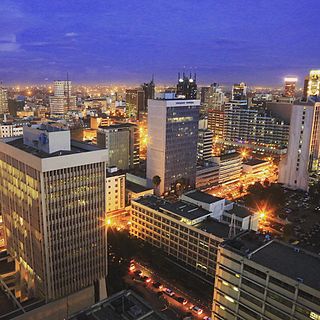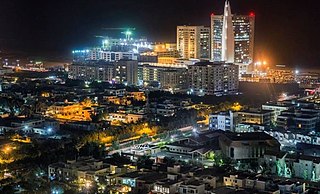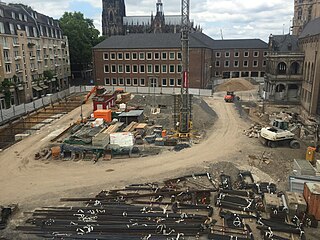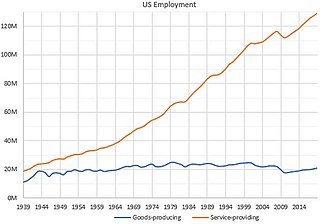Related Research Articles

The service sector is the third of the three economic sectors of the three-sector theory. The others are the secondary sector, and the primary sector.

The economy of Kenya is a market-based economy with a liberalised external trade system and a few state enterprises. Major industries include agriculture, forestry, fishing, mining, manufacturing, energy, tourism and financial services. As of 2020, Kenya had the third largest economy in Sub-Saharan Africa, coming behind Nigeria and South Africa.

The economy of Pakistan is the 23rd largest in the world in terms of purchasing power parity (PPP), and 42nd largest in terms of nominal gross domestic product. Pakistan has a population of over 220 million, giving it a nominal GDP per capita of $1,357 in 2019, which ranks 154th in the world and giving it a PPP GDP per capita of 5,839 in 2019, which ranks 132nd in the world for 2019. However, Pakistan's undocumented economy is estimated to be 36% of its overall economy, which is not taken into consideration when calculating per capita income. Pakistan is a developing country and is one of the Next Eleven countries identified by Jim O'Neill in a research paper as having a high potential of becoming, along with the BRICS countries, among the world's largest economies in the 21st century. The economy is semi-industrialized, with centres of growth along the Indus River. Primary export commodities include textiles, leather goods, sports goods, chemicals and carpets/rugs.

The economy of South Africa is the second largest in Africa. As a manufacturing hub, it is the most industrialized, technologically advanced, and diversified economy on the African continent. South Africa is an upper-middle-income economy – one of only eight such countries in Africa. Since 1996, at the end of over twelve years of international sanctions, South Africa's Gross Domestic Product almost tripled to peak at $400 billion in 2011, but has since declined to roughly $385 billion in 2019. In the same period, foreign exchange reserves increased from $3 billion to nearly $50 billion creating a diversified economy with a growing and sizable middle class, within two decades of ending apartheid. South African state owned enterprises play a significant role in the country's economy with the government owning a share in around 700 SOEs involved in a wide array of important industries. In 2016 the top five challenges to doing business in the country were inefficient government bureaucracy, restrictive labour regulations, a shortage of skilled workers for some high tech industries, political instability, and corruption, whilst the country's strong banking sector was rated as a strongly positive feature of the economy. The nation is among the G20, and is the only African member of the group.

The economy of Bahrain is heavily dependent upon oil and gas. The Bahraini currency is the second-highest-valued currency unit in the world. Since the late 20th century, Bahrain has heavily invested in the banking and tourism sectors. The country's capital, Manama is home to many large financial structures. Bahrain's finance industry is very successful. In 2008, Bahrain was named the world's fastest growing financial center by the City of London's Global Financial Centres Index. Bahrain's banking and financial services sector, particularly Islamic banking, have benefited from the regional boom driven by demand for oil. Petroleum production is Bahrain's most exported product, accounting for 60% of export receipts, 70% of government revenues, and 11% of GDP. Aluminium is the second most exported product, followed by finance and construction materials.

Construction is a general term meaning the art and science to form objects, systems, or organizations, and comes from Latin constructio and Old French construction. To construct is the verb: the act of building, and the noun is construction: how something is built, the nature of its structure.
In economics, the Dutch disease is the apparent causal relationship between the increase in the economic development of a specific sector and a decline in other sectors. The putative mechanism is that as revenues increase in the growing sector, the given nation's currency becomes stronger (appreciates) compared to currencies of other nations. This results in the nation's other exports becoming more expensive for other countries to buy, and imports becoming cheaper, making those sectors less competitive. While it most often refers to natural resource discovery, it can also refer to "any development that results in a large inflow of foreign currency, including a sharp surge in natural resource prices, foreign assistance, and foreign direct investment".
The Balassa–Samuelson effect, also known as Harrod–Balassa–Samuelson effect, the Ricardo–Viner–Harrod–Balassa–Samuelson–Penn–Bhagwati effect, or productivity biased purchasing power parity (PPP) is the tendency for consumer prices to be systematically higher in more developed countries than in less developed countries. This observation about the systematic differences in consumer prices is called the "Penn effect". The Balassa–Samuelson hypothesis is the proposition that this can be explained by the greater variation in productivity, between developed and less developed countries, in the traded goods' sectors than in the non-tradable sectors.

The economy of India is characterised as a developing market economy. It is the world's fifth-largest economy by nominal GDP and the third-largest by purchasing power parity (PPP). According to the IMF, on a per capita income basis, India ranked 139th by GDP (nominal) and 118th by GDP (PPP) in 2018. From independence in 1947 until 1991, successive governments promoted protectionist economic policies with extensive state intervention and regulation; the end of the Cold War and an acute balance of payments crisis in 1991 led to the adoption of a broad program of economic liberalisation. Since the start of the 21st century, annual average GDP growth has been 6% to 7%, and from 2014 to 2018, India was the world's fastest growing major economy, surpassing China. Historically, India was the largest economy in the world for most of the two millennia from the 1st until 19th century.

Baumol's cost disease is the rise of salaries in jobs that have experienced no or low increase of labor productivity, in response to rising salaries in other jobs that have experienced higher labor productivity growth. This pattern seemingly goes against the theory in classical economics in which real wage growth is closely tied to labor productivity changes. The phenomenon was described by William J. Baumol and William G. Bowen in the 1960s.

The economy of Scotland had an estimated nominal gross domestic product (GDP) of up to £170 billion in 2018. Since the Acts of Union 1707, Scotland's economy has been closely aligned with the economy of the rest of the United Kingdom (UK) and England has historically been its main trading partner. Scotland still conducts the majority of its trade within the UK: in 2017, Scotland's exports totalled £81.4 billion, of which £48.9 billion (60%) was with constituent nations of the UK, £14.9 billion with the rest of the European Union (EU), and £17.6 billion with other parts of the world.
Australian and New Zealand Standard Industrial Classification (ANZSIC) was jointly developed by the Australian Bureau of Statistics and Statistics New Zealand in order to make it easier to compare industry statistics between the two countries and with the rest of the world.
The economy of Lethbridge is central to the commercial, distribution, financial and industrial sectors of the southern Alberta economy. Lethbridge has a trading area population of 250,000. The city was founded in 1885 as a result of local coal mining and later was buoyed by local farming and ranching. Toward the end of the twentieth century, the local economy started diversifying by focusing more on service-based industries.

The industry which has a range of businesses that deal with money like banks, insurance companies, accounting companies, finance companies, taxation, investment funds, credit companies, and few government enterprises is called the finance industry. The activities or services within this industry that cater to the economy of the country are called financial services. Therefore, the economic services provided by the finance industry in Japan are called financial services in Japan. These services are present across the world, at regional, international and national level developed economic and demographic regions such as Sydney, New York, London, Tokyo, etc.
Net Material Product (NMP) was the main macroeconomic indicator used for monitoring growth in national accounts of socialist countries during the Soviet era. These countries included the USSR and all the Comecon members. NMP is the conceptual equivalent of Gross Domestic Product (GDP) in the United Nations System of National Accounts, although numerically the two measures are calculated differently.
Globalization is a process that encompasses the causes, courses, and consequences of transnational and transcultural integration of human and non-human activities. India had the distinction of being the world's largest economy in the beginning of the Christian era, as it accounted for about 32.9% share of world GDP and about 17% of the world population. The goods produced in India had long been exported to far off destinations across the world; the concept of globalization is hardly new to India.

Manufacturing in the United States is a vital sector. The United States is the world's third largest manufacturer with a record high real output in Q1 2018 of $2.00 trillion well above the 2007 peak before the Great Recession of $1.95 trillion. The U.S. manufacturing industry employed 12.35 million people in December 2016 and 12.56 million in December 2017, an increase of 207,000 or 1.7%. Though still a large part of the US economy, in Q1 2018 manufacturing contributed less to GDP than the 'Finance, insurance, real estate, rental, and leasing' sector, the 'Government' sector, or 'Professional and business services' sector.

Occupational safety and health (OSH), also commonly referred to as health and safety, occupational health and safety (OHS), occupational health, or occupational safety, is a multidisciplinary field concerned with the safety, health, and welfare of people at work. These terms also refer to the goals of this field, so their use in the sense of this article was originally an abbreviation of occupational safety and health program/department etc.
The share of the industry of Colombia in the country's gross domestic product (GDP) has shifted significantly in the last few decades. Data from the World Bank show that between 1965 and 1989 the share of industry—including construction, manufacturing, and mining—increased from 27 percent to 38 percent of GDP. However, since then the share has fallen considerably, down to approximately 29 percent of GDP in 2007. This pattern is about the average for middle-income countries.

The economy of the Australian Capital Territory (ACT) is the fastest-growing, sixth biggest economy of Australia as of the end of the 2017-18 financial year. Since the introduction of its self-government status in 1989, and with few exceptions in 1992, 1996, and 2014, the ACT economy has exhibited positive growth at a 1991-2018 average of 3.17 percent per year. A vast majority of the economy is concentrated in Canberra, the capital city of Australia, and is composed primarily by service industries, particularly those related to the administration of federal and local government. Construction also contributes to an important part of the economy, boosted by large government-funded projects and an active residential market. In contrast to other Australian states and territories, primary sectors such as agriculture, forestry, and mining, represent a very small proportion of the economy (±1%). A negative balance of trade has characterised the ACT economy since 2012-13, with small goods trade and a growing service export industry comprised mainly by education and public administration services.
References
- 1 2 "Feature Article - Australia's Tradable Sector". Australian Economic Indicators. 1990. Archived from the original on 2011-09-19. Retrieved 2011-09-19.
- ↑ Gross, Daniel (2011-05-17). "Nobel Laureate Spence: U.S. May Have to Live with Slow Employment Growth". Yahoo! Finance. Archived from the original on 2011-09-19. Retrieved 2011-09-18.
| This international trade related article is a stub. You can help Wikipedia by expanding it. |